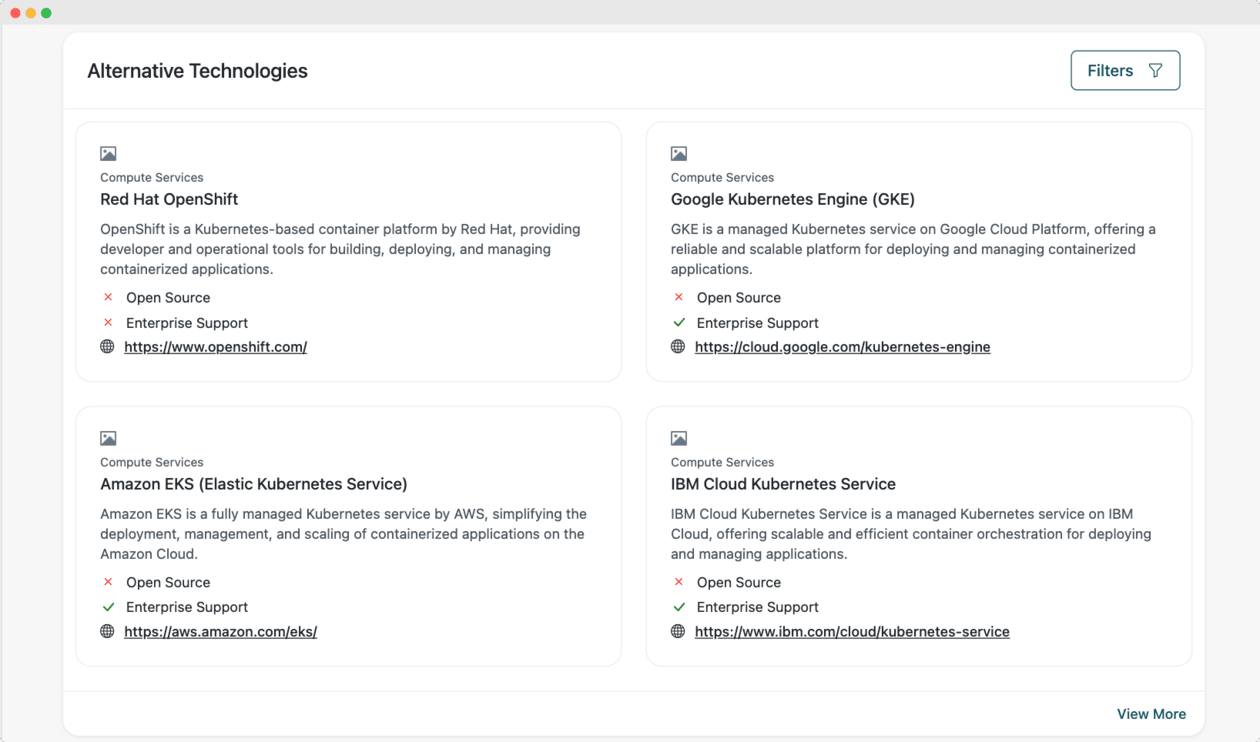
As organizations navigate the complexities of cloud exit strategies, one of the most challenging tasks is identifying suitable alternative technologies that can replace existing cloud resources and services. The Alternative Technology Analysis stage of the EscapeCloud Platform’s assessment engine is designed to simplify this process, providing a comprehensive, continuously updated dataset of available solutions on the market. This stage is crucial for ensuring that the transition out of a cloud environment is smooth, cost-effective, and aligned with the organization’s long-term IT strategy.
How the Alternative Technology Analysis Works
The foundation of the Alternative Technology Analysis lies in its extensive dataset, which is continuously updated based on market research. The assessment engine actively searches for and maps alternative technologies that can replace specific cloud resources and services. For example, if an organization’s exit strategy involves repatriation to on-premises infrastructure, the engine might suggest MinIO as an alternative to cloud storage accounts. Alternatively, if the strategy involves migration to another cloud provider, it could suggest options like AWS S3, Google Cloud Storage, Oracle Storage, or Alibaba Object Storage.
This mapping is not just a simple list of alternatives—it’s a curated dataset that considers various factors such as whether the technology is open-source, whether it offers enterprise support, and how well it aligns with the organization’s specific needs. This level of detail ensures that the alternatives provided are not only technically viable but also strategically sound for the organization’s unique requirements.
Evaluation Criteria: Mapping the Right Alternatives
The assessment engine evaluates and categorizes alternative technologies based on several criteria:
- Compatibility: The engine identifies technologies that can serve as direct replacements for existing cloud services, ensuring minimal disruption during the transition.
- Deployment Environment: Depending on whether the organization’s exit strategy involves on-premises deployment or migration to another cloud provider, the engine suggests appropriate alternatives. For example, it might recommend MinIO for on-premises storage or AWS S3 for cross-cloud migration.
- Open-Source vs. Enterprise Support: Understanding that enterprise organizations often require robust support options, the engine categorizes alternatives as either open-source or enterprise-supported. This allows users to filter results based on their support needs and risk tolerance.
- Market Stability: While the engine prefers well-established solutions, it also monitors the market for emerging technologies that may offer innovative alternatives. This ensures that the dataset remains relevant and forward-looking, providing users with options that are both reliable and cutting-edge.
User Interaction: Self-Service and Report Generation
One of the key features of the Alternative Technology Analysis is its user-friendly, self-service platform. Users can explore all the alternative technologies identified by the assessment engine, utilizing powerful filter functions to narrow down options based on resource type, open-source status, or enterprise support availability. This level of customization ensures that users can quickly find the most relevant alternatives for their specific needs, making the decision-making process more efficient.
In addition to the self-service platform, EscapeCloud also offers a PDF report that distills the analysis into a more compact format. This report highlights the top three alternatives for each resource type, providing a quick-reference guide for organizations that need to make decisions swiftly. The report is particularly useful for stakeholders who require a concise summary of their options without delving into the full dataset.
Collaboration with Key Integrators
Recognizing that transitions can be complex, EscapeCloud collaborates with key integrators who can assist organizations in implementing the alternative technologies identified by the assessment engine. These integrators bring deep expertise in both cloud and on-premises environments, ensuring that the transition is not only technically sound but also strategically aligned with the organization’s long-term goals. Whether it’s configuring a new on-premises solution or facilitating a smooth migration to another cloud provider, these partnerships enhance the overall success of the cloud exit strategy.
The Importance of Alternative Technology Analysis in Cloud Exit Strategies
The Alternative Technology Analysis stage is vital because it provides organizations with the knowledge and tools they need to make informed decisions about their cloud exit. By offering a continuously updated and meticulously categorized dataset, the assessment engine ensures that organizations are aware of all viable alternatives, reducing the risk of disruption and ensuring that the transition is as seamless as possible.
Moreover, the combination of self-service tools and expert support means that organizations have the flexibility to explore their options independently while still having access to specialized help when needed. This hybrid approach ensures that the cloud exit process is both efficient and adaptable to the specific needs of the organization.
Conclusion
The Alternative Technology Analysis provided by the EscapeCloud Platform’s assessment engine is an indispensable part of any cloud exit strategy. By mapping the most relevant and reliable alternatives for cloud resources and services, and offering tools for both self-service exploration and expert-assisted implementation, this stage ensures that organizations can transition out of cloud environments with confidence. Whether repatriating to on-premises infrastructure or migrating to another cloud provider, the insights gained from this analysis are crucial for ensuring a smooth, strategic, and successful exit.

